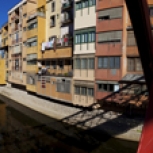
Girona
Girona is a city in Catalonia with plenty of character, a very rich heritage and an imposing set of historical monuments. With a population of about 100,000 it has been called the ‘city of four rivers’ as it lies at the confluence of the Ter, Güell, Galligants and Onyar. Girona occupies a strategic site halfway between Barcelona and the French border, close to the Costa Brava, and is a traditional transit point between the northeast part of the Iberian Peninsula and the rest of Europe.
Girona’s historic old town includes an ancient cathedral and a fortified precinct surrounded by Roman walls and lookout towers. It is particularly popular with tourists. More than 2,000 years of history are housed in two fortified areas, the Força Vella and the Medieval Quarter. The Força Vella dates back to the Roman era while the medieval extension of the city walls was carried out during the 14th and 15th centuries. The Plaça de la Independència square is another major landmark. The city’s development as a tourist destination has been helped by the decision by low-cost carrier Ryanair to use the Girona-Costa Brava Airport as a European hub. Tourism is a key driver in a local economy where the service sector provides two thirds of the activity, and industry one third.
Girona is an administrative, commercial, educational and tourism centre in its own right, yet it also has a very close regional relationship with Barcelona, which is 99km away to the southwest and just an hour away by train. That link is part of the reason behind the recent 10,000m2 Girona Auditorium and Conference Centre, a means of developing the growing sector of business tourism.

